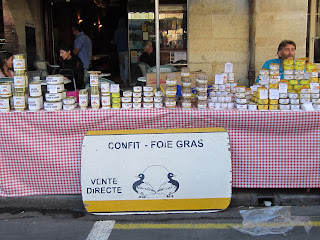In between slurping a dozen fresh oysters, munching a bit of duck paté and sipping a lovely white wine from the Loire valley the husband leaned back contentedly and pronounced to his wife, “You know, love, despite all their hang-ups the Frogs have got it (life) sorted.”
 |
| Seafood restaurant in Brittany |
The minute you drive off the train that takes you under the English Channel and head south from Calais there is an indefinable sense that you are in a place where the quality of life is pretty good. Yes, the French economy is barely sputtering and the banks are in precarious shape. Yes, the welfare state model is near collapse. Yes, the maddening, sclerotic bureaucracy drives entrepreneurs out of the country. Yes, French politicians are exasperatingly hypocritical and often exaggerate their role in the world. And yes, French politics may be the last place in the world where definitions like ‘left’ and ‘right’ are actually taken seriously as terms of political debate. I keep waiting, vainly, for someone actually to define those terms in the modern political context.
But, and it is a very big but, somehow the quality of ordinary, everyday life continues at a very high level. And you don't have to be a hedge fund manager to enjoy it. Health care is good. A very good friend in London wound up taking her child to Paris for successful non-surgical treatment after doctors in Britain deemed the condition untreatable without major, risky surgery. The roads are much better than anything I have seen in the United States or the rest of Europe, and they are not blighted by huge billboards that only block whatever good scenery exists. The cultural life is rich and, unlike much of London, affordable. You don’t have to take out a second mortgage to go to a concert. The trains are the envy of the US and the rest of Europe. London – Paris is now just over two hours on the Eurostar. And it is just a few hours on the TGV (Trés Grande Vitesse) from Paris to any other city in France.
I used to get annoyed at the French attitude toward their outsized slice of the enormous European agriculture subsidies. Ignoring for a moment that much of the subsidy goes to large industrial farms, French officials would say that they are protecting a way of life that is central to France. One can almost hear 18th century theorists praising the noble agricultural life style over the supposed evils of commerce and, God forbid, manufacturing.
But the more I travel around rural France and spend time at local food markets the more I begin to think the French have a point. Of course France, like just about any country you visit these days, is filled with large supermarkets. But even theses giants have not displaced the local markets where the vast majority of the food on offer comes from less than 100 miles from the market. We were not far from Spain, but you can hear the locals comparing – unfavourably of course – the Spanish vegetables with their French counterparts. I used to complain about the inconvenience of the noon-time break when all the shops close for two hours. Now, I have begun to realize that kind of midday break is not such a bad thing. Maybe it's just because I'm older, but I no longer see the need to rush through the day. Take a little time and enjoy something besides work.
 |
| Just one of the selections in the Libourne market |
 |
| Roof tops in historic St. Emilion |
When you drive on secondary roads anywhere in la France profonde you see hundreds, if not thousands, of well tended farms producing everything from lavender to lamb. You are never far from a good local restaurant. Even if you have to travel the motorways you can find decent food in the stops along the way, and maps are available showing exactly what is available at each stop.
The qualitative aspects of life – food, drink, preservation of the countryside, national and local heritage, culture beyond Twitter -- remain central to one’s everyday life. Despite the real pleasure of this everyday life, you have to wonder if this way of life is sustainable in today’s economic environment. It’s not clear. Hundreds of thousands of young French people have moved across the channel to London where they believe the conditions are better for getting a job or creating something from scratch. Just walk around South Kensington and you quickly get the impression you’re in the 5th Arrondissement of Paris. French leaders may moan and groan about the perceived evils of the free-wheeling, often chaotic and cruel ‘Anglo-Saxon’ economic model, but many of their best and brightest young people clearly find it more appealing than what is available in France where bureaucracy can stifle even the most energetic entrepreneur.
In their drive to shift the French economy out of first gear, I only hope the leaders of that simultaneously wonderful and puzzling country do not sacrifice the very quality of life that makes France so unique.

